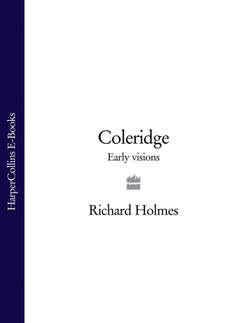Читать книгу Coleridge: Early Visions - Richard Holmes - Страница 29
5
ОглавлениеOne thing that Coleridge did not tell Mary in his letters, or George, was of his involvement in William Frend’s trial before the University Vice-Chancellor throughout the month of May 1793. Frend had published a pamphlet, Peace and Union, which became famous in the university that spring. Not only did it attack Anglican doctrines of faith, it also criticised the British declaration of war against France, and argued that Prime Minister Pitt was deliberately oppressing the poor weavers of the Midlands with war taxation. Deist and republican in tone, it strongly appealed to undergraduates like Coleridge who were questioning their own Christian beliefs, and who were fascinated by the egalitarian ideas of the French Revolution. The charge was a serious one, “sedition and defamation of the Church of England”, and the case eventually went before the Court of King’s Bench in London, that autumn, where the proceedings were recorded in the State Trials for that year.25
The atmosphere at the university had become both politicised and polarised. Not only was Tom Paine burnt in effigy; several dissenting tradesmen in the town had their business premises wrecked and were forced, like Priestley, to emigrate. A Patriotic Declaration by 112 tavern-keepers promised to report any undergraduates to the local magistrates who showed “treasonable or seditious tendencies” in their pubs and inns “by public conversation or by public reading, or circulation of any books, pamphlets, or papers”.26 The university authorities regarded Frend’s trial as crucial, and the Vice-Chancellor later wrote: “I don’t believe Pitt was ever aware of how much consequence the expulsion of Frend was: it was the ruin of the Jacobinical party as a University thing…”27
From 1793 to 1796 Coleridge would flirt with many of the ideas of the English Jacobins, as he later freely admitted in private correspondence. Yet he always denied it in his public statements after 1800, and censored his own lectures and newspaper articles accordingly when they were later republished – another clear example of his reconstructed autobiography. This flirtation began at Jesus when, as Charles Le Grice noted, Coleridge’s rooms became a centre of the Frend faction, and during the trial “pamphlets swarmed from the press. Coleridge had read them all; and in the evenings, with our negus, we had them viva voce gloriously.”28
Coleridge attended the trial in the public gallery of the Senate House, during eight days in May, and was one of the ringleaders of what the Vice-Chancellor described as “the noisy and tumultuous irregularities of conduct” which frequently interrupted the proceedings.29 On one particular day the clapping and heckling became so bad that the Senior Proctor, Mr Farish, was sent to arrest “one man who had particularly distinguished himself”, his position in the gallery having been carefully noted. This offender was in fact Coleridge; but when Farish pushed through the crowd and seized the man’s shoulder, he discovered that it was an undergraduate with a deformed arm who was quite incapable of clapping. The error produced a barrage of ironic applause, “which continued for some minutes”. What had actually occurred was observed by a Junior Fellow, Henry Gunning, who subsequently included the incident in a history of Cambridge life at this period.
The name of the young man was Charnock, and his college was Clare Hall; the real culprit was S. T. Coleridge, of Jesus College, who having observed that the Proctor had noticed him, and was coming into the Gallery, turned round to the person who was standing behind him, and made an offer of changing places, which was gladly accepted by the unsuspecting man. Coleridge immediately retreated, and mixing with the crowd, entirely escaped suspicion. This conduct on the part of Coleridge, was severely censured by the Undergraduates as it was quite clear that, to escape punishment himself, he would have subjected an innocent man to rustication or expulsion.30
Coleridge, not surprisingly, gave rather different versions of this escapade to later friends. To his newspaper editor, Daniel Stuart, who once accompanied him on a nostalgic trip to Cambridge in 1812, he recast the incident as a piece of high farce: Charnock was a man with “an iron hook” instead of a hand, and the kindly Proctor, “well knowing” that Coleridge was the real culprit who might be expelled, deliberately picked on a man who could not possibly be blamed.31 Later still, he told James Gillman that after Charnock’s arrest, he went directly to the Proctor’s office and confessed “that no innocent person should incur blame”. Farish told him that he had “a narrow escape”, and let him off.32
This may be true, though it is odd that Gunning does not mention it. Yet the pattern of extravagant behaviour, followed by remorseful confession to the authorities, is one that further emerges in 1793 and thenceforth recurs throughout Coleridge’s life, and is surely significant. Gunning’s only other comment is that Coleridge was by now renowned throughout the university for brilliant classical scholarship, flamboyant talk, and peculiar political views.33
